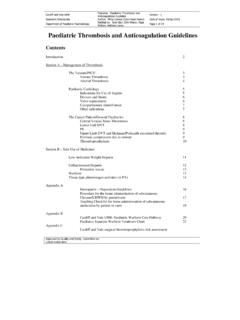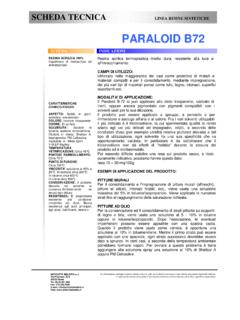Transcription of Coagulation/Clotting in neonates - Cardiff NICU
1 Coagulation/Clotting in neonates Background: The haemostasis system is complex, dynamic and influenced by age. The physiology of haemostasis in newborns differs from older children and adults. Many of the procoagulants, anticoagulants and proteins involved in fibrinolysis are gestation dependent. Vitamin K is essential for the formation of cofactors II, VII, IX and X, hence influencing the extrinsic pathway. The newborn s haemostatic system matures during infancy with most haemostatic parameters reaching adult values by 6 months of ,2 coagulation pathway: When to do a clotting screen in a neonate: 1. if actively bleeding, eg any major haemorrhage including intraventricular haemorrhage (IVH), or excessive bruising.
2 2. if unwell especially those with HIE and NEC. 3. if evidence of acute liver failure and/or metabolic disorders - urea cycle disorders, galactosaemia and organic acidaemia. 4. if undergoing surgery and has had previous bleeding problems. 5. with a family history of an inherited bleeding disorder (dependent on the coagulation factor defect, the severity of the deficiency and the likelihood of an accurate diagnosis in the neonate). Please discuss with consultant Neonatologist / Haematologist before undertaking. Reference Values (mean +/- 2 SD) for healthy term and preterm neonates Test Term1,3 Preterm (30-36weeks)2,3 Preterm (< 30 weeks)4-7 PT(s) - - 11 - 22 APTT (s) 31 - 55 27 - 79 28 - 101 Fibrinogen (g/l) - It is difficult to establish a normal reference range for preterm babies 29 weeks and below due to lack of robust evidence.
3 The available evidence (limited to small studies and abstracts) suggests that the normal range of PT and APTT vary widely. Limited evidence informs this particular reference range: only one paper with 46 neonates , no long term follow up; and one retrospective case note review in abstract form only. 4,5 For APTT again the evidence is lacking, only 3 studies with less than100 neonates in total studied, one of which dates from 1978, and one a retrospective case note review. 4-7 Despite this, these ranges has been adopted by the UK BTS handbook of transfusion medicine, therefore please interpret with caution. clotting profiles in extremely preterm babies should be done only when clinically indicated and any treatment should be discussed with the consultant.
4 What to do if active bleeding: 1. A full blood count and clotting should be requested. A free flowing venous sample is preferred and filled up to the white mark on the tube (dark blue). Arterial catheter samples can be used after withdrawing 5mls of blood and indicate on the card that the sample is heparinised. The sampling method is the same regardless of the indications for the investigation. 2. Check if Vitamin-K has been given, if not administer IV. Avoid IM injections and invasive procedures (if necessary discuss with consultant on-call). 3. Give FFP 20mls/kg over an 4. Use cryoprecipitate 10ml/kg if the coagulopathy is not responding to FFP or if fibrinogen is low, at a rate of 20mls/ (please discuss with consultant Haematologist / Neonatologist).
5 5. Repeat coagulation profile if active bleeding continues. Note: The above dose of FFP is expected to sufficiently correct a factor deficiency by approximately 30%. Shortening of the prolonged clotting times is unpredictable and should be checked following administration. References: 1 .Andrew M, Paes B, Milner R, Johnston M, Mitchell L, Tollefsen DM, et al. Development of the human coagulation system in the full-term infant. Bloo. 1987 Jul;70(1):165-72. 2. Andrew M, et al. Development of the human coagulation system in the healthy premature infant. Blood. 1988 Nov;72(5):1651-7. 3 UK blood transfusion & Tissue Transplantation services, Handbook of Transfusion medicine, 4th edition, January 2007. 4 Salonvaara M, et al.
6 Effects of gestational age and prenatal and perinatal events on the coagulation status in premature infants. Arch Dis Child Fetal Neonatal Ed. 2003 Jul;88(4):F319-23 5 Neary E et al. coagulation profile in very preterm infants. Irish American Spring meeting October 2011 6 Barnard D et al. coagulation Studies in Extremely Premature Infants. 13: 1330-1335 7 Andrew M et al. Development of the hemostatic system in the neonate and young infant. Am J Ped Hematol Oncol. 1990 12:95-104 8 Platelets, Frozen Plasma, and Cryoprecipitate: What is the Clinical Evidence for Their Use in the Neonatal Intensive Care Unit? Brandon S. Poterjoy, Cassandra D. Josephson, MD. Semin Perinatol 33:66-74 2009 Dr Sri Natti, Dr Sybil Barr.
7 November 2012 to be re-reviewed November 2015







